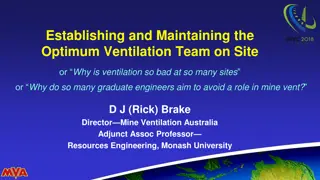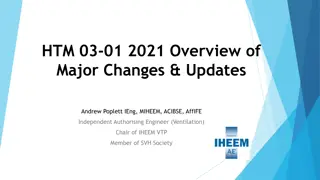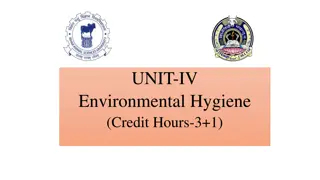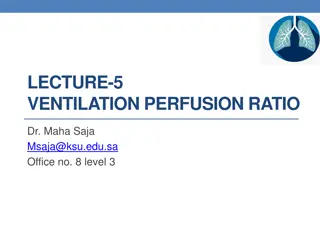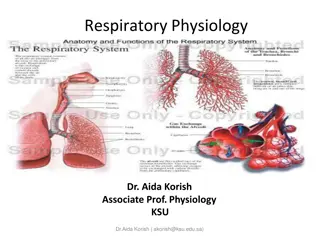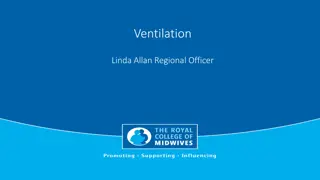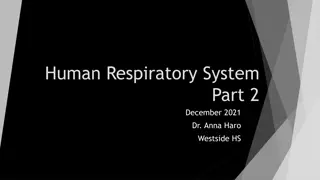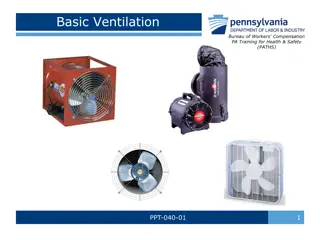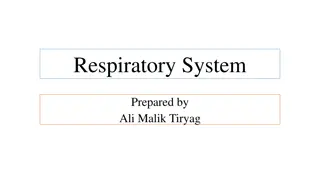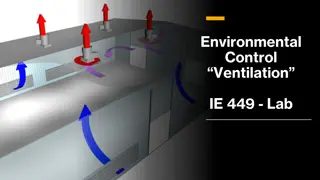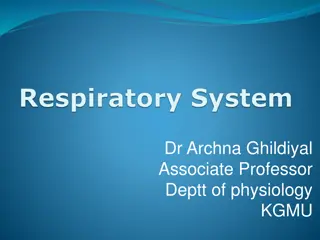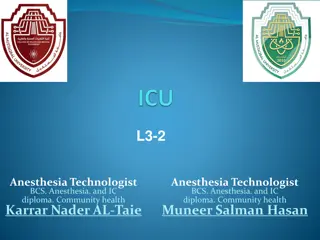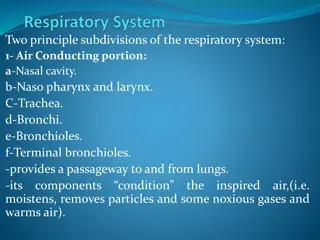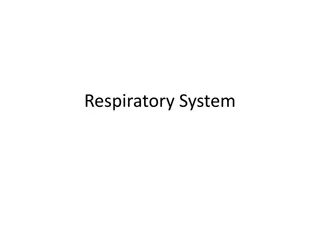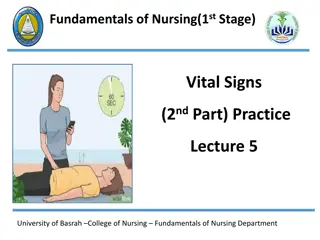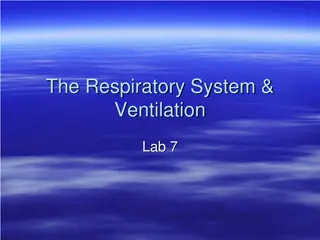Functions of the Respiratory System and Ventilation Mechanism
The respiratory system performs crucial functions such as ventilation to facilitate gas exchange, maintaining pH balance, and enabling vocal sounds. It consists of the upper and lower respiratory systems, including structures like the nose, trachea, bronchi, and alveoli. The system's epithelium, the pseudostratified ciliated columnar epithelium, aids in filtering and clearing air. Muscles of ventilation play a role in normal breathing and forceful breathing during activities like exercise. The system operates through pressure differentials to facilitate inspiration and expiration effectively.
Download Presentation

Please find below an Image/Link to download the presentation.
The content on the website is provided AS IS for your information and personal use only. It may not be sold, licensed, or shared on other websites without obtaining consent from the author.If you encounter any issues during the download, it is possible that the publisher has removed the file from their server.
You are allowed to download the files provided on this website for personal or commercial use, subject to the condition that they are used lawfully. All files are the property of their respective owners.
The content on the website is provided AS IS for your information and personal use only. It may not be sold, licensed, or shared on other websites without obtaining consent from the author.
E N D
Presentation Transcript
Functions of Respiratory System Ventilation - moves air from the atmosphere to and from alveoli in the lungs. Provides enormous Surface area for gas exchange between alveoli and circulating blood. Helps regulate pH of body fluids. Permits vocal sounds.
Upper Respiratory System Nose Nasal cavity Pharynx (throat) Larynx Conditions inspired air: Filter Warm Humidify Lower Respiratory System Trachea Bronchi Bronchioles Alveoli gas exchange! Functions to conduct air to site of gas exchange.
Vocal Folds Interesting video on how VOCAL CORDS work for Speech and Singing: https://www.youtube.com/watch?v=ZLgAQTMgZ6g
is Pseudostratified Ciliated Columnar (PSCC) epithelium Respiratory Epithelium is a wet, sticky, protective surface covering most of the respiratory tract The cilia ( hair ) beat rhythmically creating a motion/current that sweeps mucus along with debris/particulates up from the lower bronchi and trachea toward the pharynx.
Air Moves Down its Pressure Gradient Inspiration Air moves from outside into lungs as volume in the thoracic cavity increases (thus, pressure decreases). Expiration Air moves from lungs to outside as volume in the thoracic cavity decreases (thus, pressure increases). The Volume and Pressure Differences for Breathing
Muscles of Ventilation Eupnea Quiet normal breathing at rest. Inspiration: Diaphragm and External intercostals. increases volume elastic recoil Expiration: No Muscle Contraction! *Metabolic cost of breathing normally ~ 3% of basal metabolic rate (BMR)
Muscles of Ventilation Forceful Breathing e.g., during exercise. Inspiration: Diaphragm & External intercostals (scalenes and sternocleidomastoid also involved) Expiration: Internal intercostals and Abdominal muscles.
3 Important Pressures 1. Atmospheric Pressure 2. Alveolar Pressure 3. Intrapleural Pressure
Respiratory System Pressures 1.Atmospheric Pressure (PATM): This is the weight of the column of air above you. This remains relatively constant. At sea level this value is 760 mmHg. The pressure in the lungs must be higher or lower than atmospheric pressure for air flow to be created. 2.Intra-Alveolar Pressure (PALV): The pressure inside the alveoli, where gas is exchanged. This normally oscillates between 758 mmHg (inspiration) to 762 mmHg (expiration). 3.Intra-Pleural Pressure (PPLU): This is the pressure inside the pleural cavity, which is filled with pleural fluid. This pressure is always less than alveolar pressure and normally oscillates between 754 mmHg (inspiration) to 758 mmHg (expiration). Transmural Pressure Gradient (trans = across, mural = wall) Since the air in the alveoli always has a higher pressure than the fluid in pleural cavity, it exerts force across the wall of the lung tissue this force keeps the lungs stretched (even when exhaling). This force opposes (or balances) the elasticity within the lungs that tend to cause lung to collapse. Atmospheric Pressure (Pressure of the air out here!) Intra-Pleural Pressure (Pressure inside the fluid filled space!) Intra-Alveolar Pressure (Pressure of air inside alveoli of lungs!) The red area and arrow in the diagram above indicates this transmural force.
Alveoli consist of 3 types of cells 1) Alveolar Type I cells thin (simple squamous epithelium) that makes the walls of alveoli for gas exchange. 2) Alveolar Type II cells release surfactant which make lungs more Compliant. 3) Alveolar Macrophages protects the alveolar surface. Releases digestive enzyme trypsin.
Alveoli also have elastic fibers Elastic recoil - pushes air out (assists ventilation). Capillaries cover 90% of alveolar surface.
Pulmonary Elasticity and Compliance Pulmonary Elasticity gives lungs the ability to recoil, allowing lungs to compress to their original shape after the force stretching them is removed. This property comes from two elements: 1) the elastin in the elastic fibers of lungs; and 2) from the surface tension on the internal surfaces of the alveoli generates by water. Pulmonary (Lung) Complianceis a measure of the lung's ability to stretch and expand. It s related to the ease with which a person can breathe in (expand the lungs). The less work required to stretch the lungs, the more compliant they are. Pulmonary surfactant made by type II alveolar cells promotes pulmonary compliance and stabilizes lung tissue. Compliance is balanced by the elasticity and surface tension of the lungs, and compliance is inversely related to pulmonary elasticity. Decrease in elastic fibers will increase lung compliance. Thickening of lung tissue will decrease lung compliance. Decreases in pulmonary surfactant will decrease lung compliance.
Partial Pressure Gradients Partial Pressure, pressure of a single gas in a mixture of gases. Air is mixture of Gases N2 O2 CO2 = 0.03% = 79% = 21% Q: What is the PO2 if PATM is 760 mmHg? PCO2? Q: Calculate the PO2 if PATM is 380 mmHg?
Factors influencing how a gas dissolves in liquid Partial Pressure gradient: Temperature: Solubility:
An individual gas in a mixture of gases moves down its Partial Pressure Gradient Exchange of O2 and CO2 in the alveoli: The CO2 moves into the alveoli from the blood. The O2 moves into the blood from the alveoli.
An individual gas in a mixture of gases moves down its Partial Pressure Gradient O2 Movement: Air to blood Blood to cells CO2 Movement: Cells to blood Blood to air
The Bicarbonate Buffer System A weak acid that resists changes in pH, and thus acts to stabilize the pH in body fluid. Directly linked to the Respiratory System. The reversible equation for this buffer (shown below) obeys the Law of Mass Action (Le Ch telier's principle). _ * * The forward direction in this equation is also referred to as going to the Right (as written here), and the reverse direction is going to the Left. *Both the forward and reverse reaction requires carbonic anhydrase. The ionization of carbonic acid occurs spontaneously and requires no enzyme.
How is O2 Transported ? 2% is dissolved in plasma. 98% in carried on Heme portion of hemoglobin (Hb).
How is CO2 Transported ? ~ 10% dissolved in plasma. ~ 30% bound to globin portion of Hb. ~ 60% as HCO3-, (bicarbonate buffer)
The Colors of Arterial and Venous blood differ due to how much O2 is loaded onto Hemoglobin. Hb exists in 2 forms: Deoxyhemoglobin = Hb Oxyhemoglobin = HbO2 Systemic Circuit: Arterial blood highly oxygenated and is bright red. Venous blood is less oxygenated (deoxygenated) and is dark reddish-purple and can also be seen in the body as blue. Over 95% of arterial blood is HbO2 About 40-80% of venous blood is HbO2
More Info on Hb and Gas Transportation in the Body The heme portion of Hb reversibly binds to O2. The very same heme portion of Hb also bind to CO (carbon monoxide), thus CO and O2 compete for binding the same site. Note: CO binds with about 200 times the affinity! Therefore, if there is even a small amount of CO it will displace binding of O2. The globin portion of the Hb reversibly binds CO2. Note: The CO2 and the O2 do not compete for the same binding site on the Hb. However, when one is bound to Hb, it decreases the affinity for the other to bind!
Factors that Shift the Hb-O2 Saturation Curve * pH of surroundings: * Temperature: * PCO2: * 2,3-DPG:
Fetal Hb Fetal Hemoglobin (HbF) is different from Adult Hb. Structurally the subunits for HbF are: 2 -subunits and 2 -subunits (gamma, not beta!) Functionally HbF binds to O2with greater affinity than adult Hb. In this way it advantages the capturing of O2 by the developing fetus from the mother's bloodstream. Typically, by about 6 months old the newborn s HbF is virtually completely replaced by the adult form of Hb.
Fetal Hb The difference in O2 affinity is due to the gamma subunits, which are different to beta by only a single amino acid (#143): HbF has serine instead of histidine, giving it a greater affinity for O2. The HbF does not interact 2,3-DPG. As we already know, in adults, the 2,3- DPG made by RBCs decreases the affinity of Hb for O2.
Air Flow = P/R R is? P is? Airway Resistance Diameter Bronchodilation Bronchoconstriction Tertiary bronchi Terminal bronchioles Respiratory bronchioles Alveolar ducts Blockage (e.g., mucous)
For best gas exchange need: - Wet surface - Thin epithelia - Large surface area - Little ECF Some Diseases: Emphysema Fibrotic Lung Pulmonary edema Asthma Bronchitis
Common Lung Diseases AsthmaChronicBronchitis Collapsed Lung Pneumonia Tuberculosis Cystic Fibrosis Emphysema Pulmonary Hypertension Allergies Lung Cancer COPD Restrictive Lung Diseases
Volumes Capacities Vital capacity Inspiratory capacity Total Lung capacity Tidal volume Inspiratory reserve volume Expiratory reserve volume Residual volume


